We built a Fort!



Duringadiscussion aboutcelebrating Diwali during theArtclass, childrenwereasked how they celebratediwali at home and howtheywould like tocelebratediwali at school. In thesame context,theteacher spokeabout her own childhoodmemories of Diwalicelebrationin Mumbai (Maharashtra).Shementioned thatthey usedto make miniature Fort models whichwas a traditionalactivity of kids in that region. This wasan activity for thekids to collaborateand workin team. They could also learnof a bit of historydoing it.
Children showed greatexcitement and started talkingaboutforts!
Rishaan Milanta:Iknow,Isawitat Goa.Ithadtallstonewalls andasoldierwasstandinginfrontofitandprotectingit.
Mukund:Itis whereNarendraModigiveshisspeechon IndependenceDay.Itis RedfortandItis a bigbuilding
Teacher:Oh didyougothereon IndependenceDay?
Mukund:No, Isawiton T.V.
Children: Misswhydidyoumakeforts?
Teacher:Weusedtomakefortstoknowaboutthehistory. MarathakingShivajihadbuiltmanyfortsinmountainareas.
Mukund: OhI knowShivaji,IsawhisstatuenearSankeytank
Seeing theirunderstanding and interest regarding Forts, the teacherthought of taking the idea of “Forts” forward,to see whatthe children mightcome upwith.
Thenext day, children were read out some information about the traditionof making forts in the Maratharegion of India.
Fort making is a peculiar tradition in Maharashtra state. Children make small mud forts during Diwali, place small figurines on them and light oil lamps. Maharashtra has more than 350 forts and they are a glorious heritage of the Maratha Empire. Many of these forts are associated with Shivaji Maharaj, the great Maratha king.
It is said that when Shivaji Maharaj was young, he used to make mud forts with his playmates and recreate a war scene. As a memory of that, kids build the forts during Diwali. This in a way also helps kids to enrich their Knowledge of history in a fun way.
The forts of Maratha kingdom played very important role in the safety of the kingdom.
They still serve as an example of excellent architecture. They were built so tactfully that they’re still going strong. To inculcate this value, the mud forts are built in Diwali.
Picturesof King Shivaji and Forts were putup as provocations...



...Also some forts builtbychildren traditionally usingclay

Children noticed the main characteristicsof the fort:
Fort has tallstrong walland waterbody (trench) around thefort for theprotection, huge gateat the entrance, lots of steps...
Khushi:Miss not only elephants, the camelsand horses also had to walkthroughthe gate.Like they have camel,horse and elephant inthe gameof chess withsoldiers toprotect theking and the queen!
Observing the forts made by children, they were curious...
Bhumi:How did they make it?
Aria:They have used bricksand clay.
Ishaan:They have used stones and wood.
Teacher’s observations: Children were displaying curiosity and eagerness to investigate further. So catching on to this spontaneous teaching moment, the children could be encouraged to delve deeper into the study of forts.
How canwe build a fort? Whatmaterialsdo you thinkwe canuse?
Khushi:We can use clay
Navika:We can use paper
Aarnav:I thinkwe canmake it withwood blocks
Shrinayana:I canuse sand from sand pit
Anika and Niheera:We canuse cotton
Ishaan:Miss wecan use Lego blocks
Samaira:We canuse boxes to make it
Children cameup withthe list of materialsthey thoughtthey could use to make the fort.
Teacher’s observations:
Children found a purpose and understood that making a “list” would help them plan their project, displaying their literacy skills.




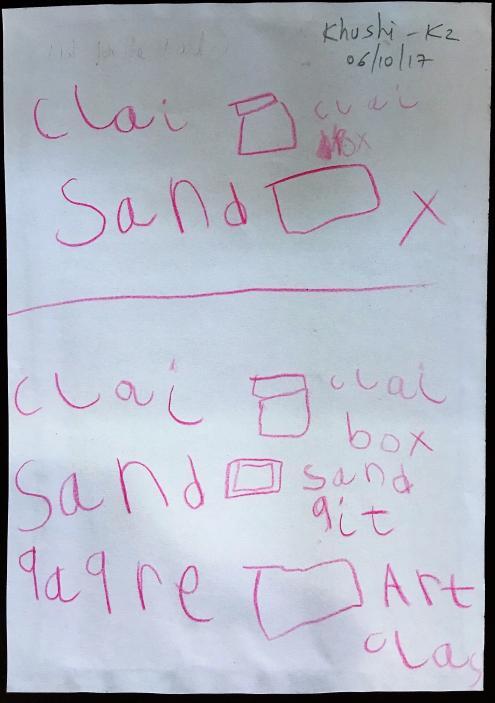
We can make it in theclaycentre. Miss, wecan make it in the sand pitalso.
Afteran initialdiscussion of whowantsto build in whicharea, few childrendecided to make it on thetable(clay centre) in art class.
Somechildren startedcollecting the stones from the outdoor and some of them ran tothe sand pitto prepare for the fort there.


Somechildren beganarrangingthem on the table,whilesome othersgot busy making “soldiers” withclay.


Oncethey collected stones , thechildren arranged the stones and startedlayering themwithclay.


Children:Missthese stonesare falling down!
.
Thenfew childrencame up withthe idea of makinga wallaroundit withthe wooden blocks,So that their stonesare secured within Devrana:We can keep them like this (Placing woodenblocks vertically) to make it tall.
Theylater added lego blocks over the woodenblocks to add heightand colour to theirfortwall.


During theprocess of building their fort,some children kept referring to theprovocation pictures of fort models.




Teacher’s observations: Children worked collaboratively, listening to each other’s ideas and discussing the plans. There was very little friction and disagreements.
Mukund:I willmake Shivaji!I have seen his statue,he is sittingon a horse. He went and got a toy horse from the sand pit.
“First I willmakesaddle on the horse. See Imade it.”
Then he made legs and body, head withthe turban.
“Miss,there is a shield on his backand swordin one hand.”

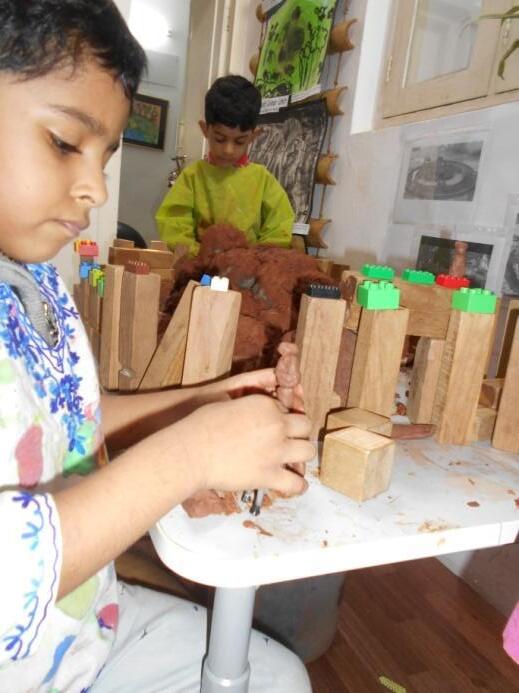
Teacher’sobservations:Mukund displayed a dispositionof goodobservationand memoryto make Shivaji’s statue onthe toy horseusing clay. He also displayed good claymodelling skills.

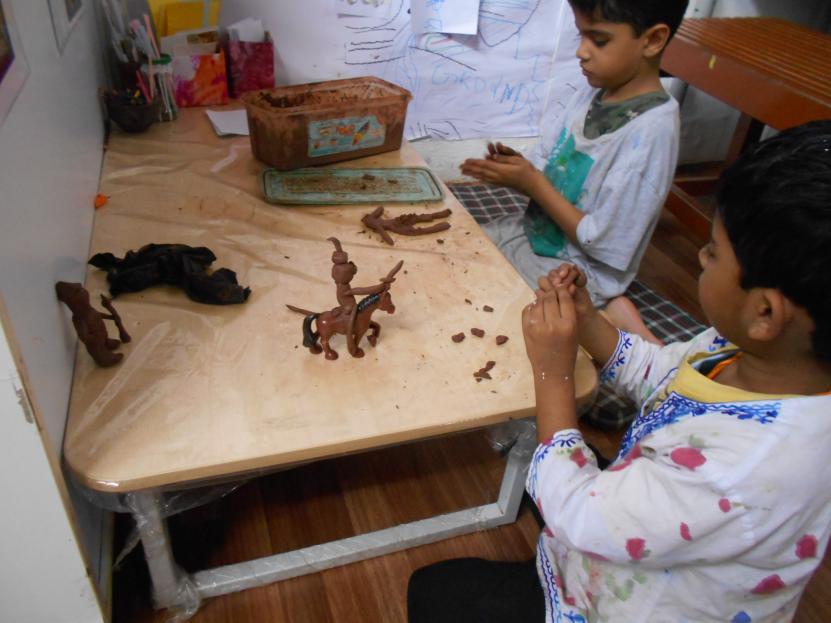




Oncehewassatisfied withhiswork,Mukund placedhisstatueof Shivajion thetopofthemoundsaying,“Theking shouldbeput here.”


Thefinal Fort withan entrance and the statueof Shivaji!
Children wentto thesandpit and startedlooking for a placeto buildafort. Theyfigured thatplace under thejungle gymwouldbe safe and protected..

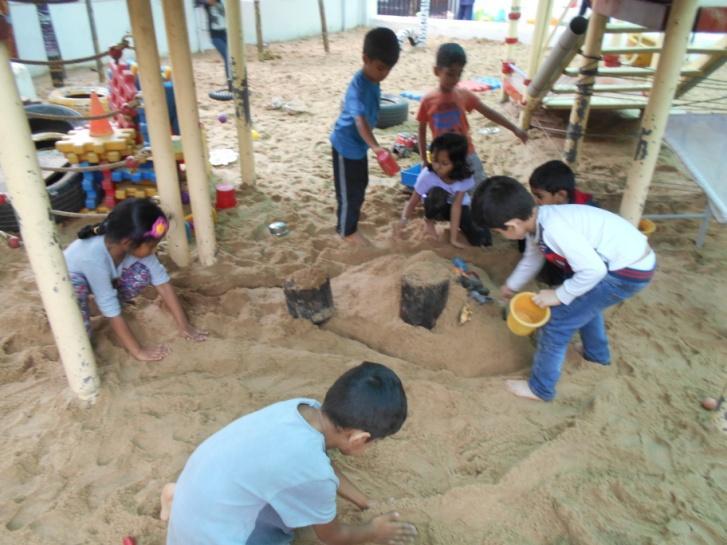
Afterlittleprovocation, children cameup withaplan and started working.They dug up atrench (Khandak) for waterbody around thefort,a surrounding wallwasbuilt and wooden logs were kept for theentrance.


Ishaan:We can use these (Big interlocking blocks)blocks for wall.He starteddigging andplacingthem vertically


He and another child ran toget animalsfrom anotherarea and placedthemon themound.


Ishaangotthe waterplay channelsand placed them aroundover the ditch, Saying,”We can put waterin this.”
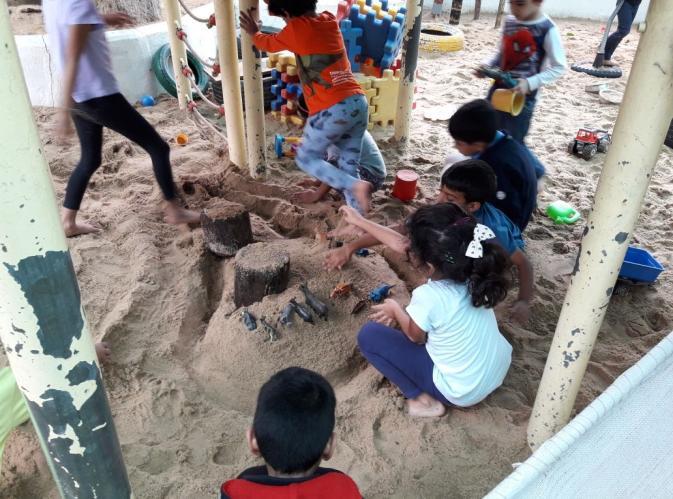



Inthe sandpit, children started working on their fort. While they wereworking, K1,Pre-K and Toddler children were walkingand runningthrough. The fort wasnot comingup.
Sidhant:We are working from ages it’s not completingonly.
Anika:Yes these (Toddler, Pre-K and K1) children are coming and breaking weneed tobuild a wallto protect our fort.
Children used the biginterlocking blocksto build thewallaround theirfort, whichwasnot working.
Khushi:We can use thewooden logs.
Shestarted gettingthelogs withthe help of Dev Rana. They realised the logs are heavy. They went to the Securityperson andasked him,” Can you please helpus put the logs there? It is very heavy!”
Teacher’sobservations:Children did notgiveup whenthe fortwas beingdestroyed by youngerchildren.Theythought of innovative waysto protecttheir creation.Also findingsolutions whenthey wereunable to act upon theirideas.
Under the supervision of the teacher,the Securityperson helped themplace thewooden logs where the children wanted.


Viren:We can make a deep ditchso these(Toddlers, Pre-k and K1) children can’tgetin.
Ishaan:Yesthat willhelp


Viren,Ishaan, Srinayna,and Omar starteddigging ditch around. Whiledigging they said excitedly,”See Miss! We found hidden treasures!!!”
Theygotdigging withincreased enthusiasm and found a glass,a toy boat,aballand a steel vessel !!
Seeing theboat, Viren: I think thisis apirate’s boat,whichhas sunkand becamesmall. Let’s dig more wewillgetmore treasure.
Viren:I found aroot
Ishan:Don’t break it!It’s tree root.






Children continued making changesand improvements totheir “Fort”tillit wastime toleave for theday. Children requested thehouse staff in chargeof thesand pit, not to disturb it throughtheweekend as they wantedto workon iton Monday.
Teacher’sanalysis: Childrenwereengagedandengrossedon the taskand continuedworkingon the fort.
Childrenwereactingwithincreasingindependenceand perseverance
•Buildinga confidentself-identity.
•Buildingpositiverelationshipswithothers
•Showingincreasingrespectfor diversityBuilding positive dispositionsand approaches towardlearning
•Increasingconfidenceand involvementinlearning
•Engagingin waysto be imaginativeandcreative Exploringand expandingwaysto use language
•Exploringand engagingwithliteracyin personallymeaningful ways